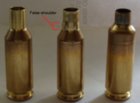What length should I be trimming BR to that I’m fireforming into dasher. .272 neck so I’m trimming to length, turning the neck to create a false shoulder and then fireforming.
You are using an out of date browser. It may not display this or other websites correctly.
You should upgrade or use an alternative browser.
You should upgrade or use an alternative browser.
Trim length for BR to fireform to dasher
- Thread starter Cody Richardson
- Start date
I haven’t ever had to trim
I don’t use the false should also
I like flat bass bullets jamming
I don’t use the false should also
I like flat bass bullets jamming
dmoran
Donovan Moran
Likely your chamber is long enough to not need to trim the brass before fire-forming (but do need to make sure of this).
Do you have a blue-print of the reamer used, or access to one?
If so, it will tell you the length of the chamber.
Unless you worded it wrong of your planned process, and your chamber neck diameter is .272", it is to large to false-shoulder off a neck cut. You will have to create a false shoulder by expansion of the neck and partially sizing part of it back down (attaching a picture below).
It has been my experience, the false-shoulder method forms the most consistent cases to lengths and capacities.
Myself do no trimming until they have been fired at least twice, then by trimming the longest ones to the shortest ones lengths.
I also qualify the lengths before doing so, cuing out any extremes (shorts).
In the picture below:
1. Neck turned to the shoulder junction.
2. Expanded the necks with a .264" mandrel.
3. Partial neck sized back down with a bushing neck die (can be done with a F/L die as well).
4. Suggest at least .020" of crush to the false-shoulder on bolt closer.

Do you have a blue-print of the reamer used, or access to one?
If so, it will tell you the length of the chamber.
Unless you worded it wrong of your planned process, and your chamber neck diameter is .272", it is to large to false-shoulder off a neck cut. You will have to create a false shoulder by expansion of the neck and partially sizing part of it back down (attaching a picture below).
It has been my experience, the false-shoulder method forms the most consistent cases to lengths and capacities.
Myself do no trimming until they have been fired at least twice, then by trimming the longest ones to the shortest ones lengths.
I also qualify the lengths before doing so, cuing out any extremes (shorts).
In the picture below:
1. Neck turned to the shoulder junction.
2. Expanded the necks with a .264" mandrel.
3. Partial neck sized back down with a bushing neck die (can be done with a F/L die as well).
4. Suggest at least .020" of crush to the false-shoulder on bolt closer.

Last edited:
drags
Silver $$ Contributor
Likely your chamber is long enough to not need to trim the brass (but you will need to make sure of this).
Do you have a blue-print of the reamer used, or access to one?
If so, it will tell you if the length of the chamber.
Unless you worded it wrong of your planned process, and your chamber neck diameter is .272", it is to large to false-shoulder off a neck cut. You will have to create a false shoulder by expansion of the neck and partially sizing part of it back down (attaching a picture below).
It has been my experience, the false-shoulder method forms the most consistent cases to lengths and capacities.
Myself do no trimming until they have been fired at least twice, then by trimming the longest ones to the shortest ones lengths.
I also qualify the lengths before doing so, cuing out any extremes (shorts).
In the picture below:
1. Neck turned to the shoulder junction.
2. Expanded the necks with a .264" mandrel.
3. Partial neck sized back down with a bushing neck die (can be done with a F/L die as well).
4. Suggest at least .020" of crush to the false-shoulder on bolt closer.
Hi dmoran, I do everything that you have described here except turning down to the shoulder junction, I turn just far enough down the neck so that the turned part of the neck goes in to the shoulder after fire forming. Why do you turn into the shoulder junction?
View attachment 1084381
Similar threads
- Replies
- 6
- Views
- 1,271
Upgrades & Donations
This Forum's expenses are primarily paid by member contributions. You can upgrade your Forum membership in seconds. Gold and Silver members get unlimited FREE classifieds for one year. Gold members can upload custom avatars.

Click Upgrade Membership Button ABOVE to get Gold or Silver Status.
You can also donate any amount, large or small, with the button below. Include your Forum Name in the PayPal Notes field.
To DONATE by CHECK, or make a recurring donation, CLICK HERE to learn how.

Click Upgrade Membership Button ABOVE to get Gold or Silver Status.
You can also donate any amount, large or small, with the button below. Include your Forum Name in the PayPal Notes field.
To DONATE by CHECK, or make a recurring donation, CLICK HERE to learn how.









